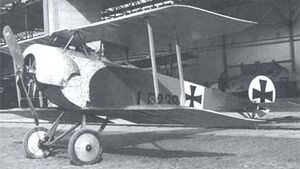Engineering:Fokker D.II
| Fokker D.II | |
|---|---|

| |
| Role | Fighter |
| Manufacturer | Fokker-Flugzeugwerke |
| Designer | Martin Kreutzer |
This article includes a list of references, related reading or external links, but its sources remain unclear because it lacks inline citations. (January 2024) (Learn how and when to remove this template message) |
The Fokker D.II was a German fighter biplane of World War I. It was a single-seat fighter aircraft developed before the Fokker D.I. It was based on the M.17 prototype, with single-bay unstaggered wings and a larger fuselage and shorter span than production D.IIs. Using a 75 kW (100 hp) Oberursel U.I, the D.II was underpowered, though the single 7.92 mm (.312 in) lMG 08 machine gun was normal for 1916. The German Army purchased 177.
Operational history
In service, the D.II proved to be little better than the earlier Fokker Eindecker fighters - in particular, it was outclassed by the Nieuport 11 and 17. A few examples were used by the Kampfeinsitzerkommandos and the early Jagdstaffeln alongside the Halberstadt D.II but the early Fokker biplanes were quickly discarded when the new Albatros fighters came out.
Operators
 German Empire
German Empire
- Luftstreitkräfte
 Netherlands
Netherlands
- Koninklijke Marine
 Switzerland
Switzerland
Specifications (D.II)
General characteristics
- Crew: one pilot
- Length: 6.40 m (21 ft 0 in)
- Wingspan: 8.75 m (28 ft 9 in)
- Height: 2.55 m (8 ft 4 in)
- Wing area: 18.0 m2 (194 sq ft)
- Empty weight: 384 kg (847 lb)
- Gross weight: 575 kg (1,268 lb)
- Powerplant: 1 × Oberursel U.I rotary , 75 kW (100 hp)
Performance
- Maximum speed: 150 km/h (93 mph, 81 kn)
- Range: 200 km (124 mi, 108 nmi)
- Service ceiling: 4,000 m (13,125 ft)
- Rate of climb: 4.2 m/s (820 ft/min)
- Wing loading: 31.0 kg/m2 (6.3 lb/sq ft)
Armament
- 1 × fixed, forward-firing 7.92 mm (.312 in) lMG 08 machine gun
References
- Taylor, Michael J. H. (1989). Jane's Encyclopedia of Aviation. London: Studio Editions. pp. 399.
- World Aircraft Information Files. London: Bright Star Publishing. pp. File 894 Sheet 40.
 |


